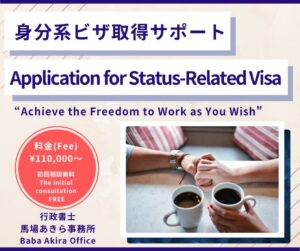"What Happens to the Residency Status of Spouses of Japanese Nationals? A Guide to Post-Divorce Procedures" Part 4
Specific Procedures for Changing Residency Status
Topic: Steps and Tips for Changing Residency Status to Continue Living in Japan After Divorce
To continue living in Japan after a divorce, you must apply to change your residency status. This process involves clearly defined procedures, and proper preparation is key to success. This article explains the step-by-step process, required documents, and important considerations for changing your residency status.
1. Basic Steps for Changing Residency Status
(1) Choose the Appropriate Residency Status
Decide which residency status you will apply for after divorce. Common options include:
- Long-Term Resident Visa: For individuals with an established life foundation in Japan.
- Work Visa: For those with an employment contract in Japan.
- Other Visas: Options include family stay, student visa, etc.
(2) Prepare the Required Documents
Gather the documents needed for your specific residency status application. Details are provided below.
(3) Submit the Application to the Immigration Bureau
Submit your application and documents to the nearest Immigration Bureau. Be prepared to explain your reasons for the change and your future plans if questioned during submission.
(4) Points to Note During the Review Period
The review process can take several weeks to months. During this time, your current residency status remains valid, so you can continue your daily life as usual.
(5) Notification of Results
You will receive the results via mail or at the Immigration Bureau. If approved, you will be issued a new residence card. If denied, review the reasons provided and consider next steps.
2. List of Required Documents
The documents required depend on the residency status you are applying for, but generally include:
(1) Basic Documents
- Application form for permission to change residency status (available at the Immigration Bureau)
- Passport and residence card
- Divorce acceptance certificate or proof of divorce
- A passport-size photo (4cm x 3cm, attached to the application form)
(2) For Long-Term Resident Visa Applications
- Documents proving a stable life foundation in Japan (e.g., housing contract, bank statements)
- Proof of income (e.g., pay slips, tax certificates)
- If you are a custodial parent, documents like the child’s family register or school enrollment certificate
(3) For Work Visa Applications
- Employment certificate issued by your employer
- Copy of your employment contract
- Documents explaining job details (e.g., brochures showing job scope)
- Proof of educational background or work experience (e.g., graduation certificate, resume)
3. Key Points Considered During the Review Process
(1) Stable Life Foundation
- Stability in income and housing is a crucial factor in the review process. Prepare documents such as a housing lease contract or proof of bank balance.
(2) Reasonable Justification for Continuing Life in Japan
- Clearly explain your life foundation in Japan, such as long-term residence, participation in community activities, or other social ties.
- If applicable, emphasize reasons related to raising or educating your children.
(3) Alignment with the New Residency Status
- For work visa applications, demonstrate that your employer offers legitimate job opportunities and that you have the qualifications to perform the role.
4. What to Do If Your Application Is Denied
If your application is denied, consider the following steps:
- Check the Reason for Denial: The notification will state the reasons for denial. Identify missing documents or issues raised during the review.
- Reapply: Address the deficiencies and submit a new application.
- Consult Professionals: Seek advice from administrative scriveners (gyoseishoshi) or lawyers for guidance on the next steps.
Conclusion
Changing your residency status is a crucial step to continue living in Japan after a divorce. By gathering accurate information and preparing the necessary documents, you can ensure a smoother application process. In the next article, we will discuss "Post-Divorce Life Support and Available Resources."
